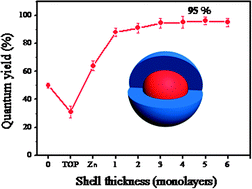A tri-n-octylphosphine-assisted successive ionic layer adsorption and reaction method to synthesize multilayered core–shell CdSe–ZnS quantum dots with extremely high quantum yield†
Abstract
Multilayered ZnS shells are coated on a CdSe

* Corresponding authors
a
Single-Molecule Detection and Imaging Laboratory, Shenzhen Institutes of Advanced Technology, Chinese Academy of Sciences, Shenzhen 518055, China
E-mail:
zhangcy@siat.ac.cn
Fax: +86-755-86392299
Tel: +86-755-86392211
Multilayered ZnS shells are coated on a CdSe

 Please wait while we load your content...
Something went wrong. Try again?
Please wait while we load your content...
Something went wrong. Try again?
J. Hao, J. Zhou and C. Zhang, Chem. Commun., 2013, 49, 6346 DOI: 10.1039/C3CC43147A
To request permission to reproduce material from this article, please go to the Copyright Clearance Center request page.
If you are an author contributing to an RSC publication, you do not need to request permission provided correct acknowledgement is given.
If you are the author of this article, you do not need to request permission to reproduce figures and diagrams provided correct acknowledgement is given. If you want to reproduce the whole article in a third-party publication (excluding your thesis/dissertation for which permission is not required) please go to the Copyright Clearance Center request page.
Read more about how to correctly acknowledge RSC content.
 Fetching data from CrossRef.
Fetching data from CrossRef.
This may take some time to load.
Loading related content
